

This is an aerial photograph of Owens Lake by David Maisel, part of this travelling exhibit:
Quoting from the online catalog:
Owens (Dry) Lake in California is a beautiful place to be. The red dust swirling all around gives off a rich, vibrant sheen of color as the wind kicks up the dust. What one doesn't realize when one sees this dust is that it is highly toxic. Yet this wasn't always the case.Everywhere I've ever been, natural landscapes make me feel happy — even the most desolate deserts. Humans have a unique ability to create environments I find depressing. Some are melancholy, unloved, like a dimly lit highway overpass at night covered with graffiti, or this building I saw this month in Shanghai:In the past, Owens Lake would overflow frequently to the south. It had done so like clockwork for about 800,000 years. During the late 1800s and early 1900s, the lake varied in depth between five and seven meters, depending on the day's conditions. However, as American settlement of the West increased, water began being diverted from the lake. Beginning in 1913, Owens Lake was diverted to Los Angeles for irrigation purposes, and by 1926 the lake was dry.
Nothing remained of the lake but brine and hardy organisms that were able to survive in such saline conditions. As a result, all of the groundwater and land became contaminated. In order to regulate somewhat this contamination, the EPA has set a maximum contamination level of 0.005 milligrams per liter of water. Regardless, the contamination levels have climbed to 23 times greater than the federal health standard allows.
The contaminated soils contain high amounts of PCE, or tetrachloroethylene. This chemical was found at the site in 1995. It is regularly used as a solvent in cleaning operations. Exposure to PCE can cause dizziness, headaches, sleepiness, confusion, nausea, difficulty in speaking and walking, unconsciousness, and death. Other side effects of this chemical are liver problems and increased risk of cancer.
To combat the problem, the Environmental Protection Agency has declared the region unfit for habitation and began reclamation efforts. The land is being tested regularly and scientists believe that the land will again be livable in as little as 70 years.

Others are almost magnificent in their devastation — ruined on a vastly extravagant scale, like Lake Owen.
More and more I've come to believe people create around them external
landscapes that match the internal landscape of their soul. Perhaps
because I do more gardening these days, I look at people's yards as I
walk to work, and I read — or imagine reading — their
personalities from their gardening. Some people don't give a damn.
Some actually go out the way to make their yard ugly, filling it with
trash. Others are a bit prim, going for rigid hedgerows. Some are
well-balanced and happy, in a wide variety of different way.
April 2, 2008
Maya Lin, the artist who created the haunting memorial for
Vietnam veterans in Washington DC, is now tackling something
even bigger.
There's more in the article. What it shows of the memorial leaves me underwhelmed, but the idea is good.Maya Lin's earthly concerns
April 1, 2008
Anne-Marie O'Connor, LA TimesSan Diego - Maya Lin has always had a deep feeling for the land. As a child, she roamed the leafy woods of the Appalachian foothills in southern Ohio, listening to the mating calls of the songbirds that filled the forest. Now Lin perceives a growing stillness, as the number of songbirds across America are decimated by habitat destruction. The growing degradation of the natural world haunts Lin — celebrated as the creator of the Vietnam Veterans Memorial and the reinventor of the American memorial genre —as she pulls together the plans for what she says will be her "last memorial."
The title of this work-in-progress, like many of the details, is evolving: Perhaps "What is Missing," perhaps simply "Missing." But the theme is clear: Lin's finale will grieve for the animals, birds and plants driven into extinction — and warn of the urgency of acting now to halt the devastation.
Lin envisions it as a multisite chronicle, including photography and video, at places around the world and with a commemorative list of names — this time the names of extinct species. It is to be launched with a memorial table on Earth Day in April 2009 commissioned by the California Academy of Sciences in San Francisco, which chose her design to include inits new building in Golden Gate Park, an academy spokeswoman said.
"Do the math, guys. Where do we want to be in 50 years? That's the question," she said at the Museum of Contemporary Art San Diego as she installed her latest exhibit in a cathedral-like gallery lighted by the afternoon sun.
I think it would be better to make replicas of 100,000,000 stuffed passenger pigeons. Lovingly mounted on individual stands in a 10,000 × 10,000 square grid, they'd make a good reminder of what we've killed so far:
Except we actually killed between 10 and 50 times as many.
From the Chipper Woods Bird Observatory site:
Their flocks, a mile wide and up to 300 miles long, were so dense that they darkened the sky for hours and days as the flock passed overhead. Population estimates from the 19th century ranged from 1 billion to close to 4 billion individuals. Total populations may have reached 5 billion individuals and comprised up to 40% of the total number of birds in North America (Schorger 1995). This may be the only species for which the exact time of extinction is known.Namely: 1:00 pm on September 1, 1914.
In the UK, the mayor of London is imposing a heavy
fee on gas-guzzling vehicles in the city center, but a
German car company is suing. In the US, the Environmental
Prevention Agency is dragging its heels on reducing CO2
emissions, but 18 states
are suing.
April 4, 2008
On Monday evening, Lisa and I are going to Shanghai. Burning carbon,
adding to the problem... I'm going to buy carbon offsets after doing
some more research on what are the best ways to do this:
I'm almost done reading this SF novel:
There's a lot about China, which makes me think of where I'll be going in 3 days. And there's a lot about California, which makes me think of life here. A long hike in the Sierras:
The stars were popping out overhead, swiftly surpassing in number and brilliance any starscapes they ever saw at home. The Milky Way was like a moraine of stars. Sound of distant water clucking through the a patch of meadow, the wind in the pines; black spiky horizons all around, the smooth airy gap of the pass behind. It was a blessing to feel so tired in such a place. They had made the effort it took to regather, and here they were again, in a place so sublime no one could truly remember what it was like when they were away, so that every return had a sense of surprise, as if re-entering a miracle. Every time it felt this way. It was the California that could never be taken away.I'm pleased to report that this spring it rained enough for a profusion of flowers in the granite hills above our house. But, this scenario reminds me very much of last year.
Except it could.Charlie had, of course, read about the ongoing drought that had afflicted the Sierra for the last few years, and he was also familiar with the climate models which suggested that the Sierra would be one of those places most affected by the global rise in temperature. California's wetmonths had been November through April, with the rest of the year as dry as any desert. A classic Mediterranean climate. Even during the Hyperniño this pattern had tended to endure, although in El Niño conditions more rain fell in the southern half of the state and less in the northern half, with the Sierras therefore getting a bit of both. In the past, however, whatever the amount of precipitation, it has fallen on the Sierra in the form of snow; this had created a thick winter snowpack, which then took most of the summers to melt. That meant that the reservoirs in the foothills got fed a stream of melting snow at a rate that could then be dispersed out to the cities and farms. In effect the Sierra snowpack itself had been the ultimate reservoir, far bigger than what the artificial ones behind dams in the foothills could hold.
Now, however, with global temperatures higher, more of the winter precipitation came down as rain, and thus ran off immediately. The annual reservoir of snow was smaller, even in good years and in droughts it hardly formed at all.
California was in an uproar about this. New dams were being built, including the Auburn dam, located right on an earthquake fault; and the movement to remove the Hetch Hetchy dam had been defeated, despite the fact that the next reservoir down the Tuolomne had the capacity to hold all Hetch Hetchy's water. State officials were also begging to Oregon and Washington to allow a pipeline to be built to convey water south from the Columbia River. The Columbia dumped a huge amount of water into the Pacific, one hundred times the maximum flow of the Colorado River, and all of it unused. It was immoral, some said. But naturally the citizens of Oregon and Washington had refused to agree to the pipeline, happy at a chance to stick it to California. Only the possibility that many Californians would then move north, bringing their obese equities with them, was causing any of them to reconsider their stance. But of course clear cost-benefit analysis was not the national strong suit, so on the battle would go for the forseeable future.
In any case, no matter what political and hydrological adjustments were made in the lowlands, the high Sierra meadows were dying.
This was a shock to witness. It had changed in the three years since Charlie had last been up. He hiked down the trail on their second morning with a sinking feeling in his stomach, able to cinch the waistbelt of his pack tighter and tighter.
They were walking down the side of a big glacial gorge to the John Muir Trail. When they reached it, they headed north on it for a short distance, going genly uphill as the trail followed the south fork of the Kings River up toward Upper Basin and Mather Pass. As they hiked, it beame obvious that the high basin meadows were much too dry for early August. They were desiccated. Ponds were often pans of cracked dirt. Grass was brown. Plants were dead: trees, bushes, ground cover, grasses. Even mosses. There were no marmots to be seen, and few birds. Only the lichen seemed okay — although as Vince pointed out, it was hard to tell. "If lichen dies does it lose its color?" No one knew.
Anyway, as you can see, this novel is slow and meditative at times.
I like that. But, it builds to quite a climax. If you read it,
I suggest reading Forty Signs of Rain and Fifty Degrees
Below first, so you know the characters and understand their
situation — it's all one big novel. But this last part is the best.
April 13, 2008
Not much on my diary the last few days — as usual, the more that's going
on, the less shows up here!
Lisa and I showed up in Shanghai on Wednesday the 9th, and on Thursday she gave her first lecture. She's giving 8 lectures on classical Chinese and Greek culture at the University of Fudan: two on Homer, two on strategy, two on medicine and two on divination. She has a nice office with her Chinese name in big letters on the door:

Actually her Chinese name is Rue Li, but apparently they preferred Li Sa.
I'll visit the CAS-MPG Partner Institute for Computational Biology, but so far I've just been working on my own. She'll stay for over a month; I'll just stay until the 26th.
We're residing in the Fudan University Dong Yuan Expert Building — academics from other countries are traditionally called "foreign experts" here. We stayed here for a few days in the summer of 2006 before moving into an ordinary apartment.
At first being here was a bit dreamlike, thanks to daze of jet lag and the strange sensation of returning to this Shanghai neighborhood, originally so strange to me in every respect, now familiar, yet half-forgotten. The fact that we're now living in a different place, and most of the streets have names beginning with Guo or Zheng, adds to this sensation: in the old days I turned off Guoquan Ho Lu and walked down Zhengsu to the market, but now I turn off Guofu Lu and walk down Zhengxiu — or something like that. Plus, every morning there's a wild storm of bird songs, since old men gather on our street with their caged songbirds:

It's cool and cloudy now instead of miserably hot and humid. It's a real blessing to be able to walk down the street and not be dripping in sweat after one block.
Our place was sadly lacking in kitchen supplies, so that was the first order of business. Luckily Lisa has some very good friends from earlier visits living right next door! So, we could borrow some cups and plates and recover the trusty rice cooker from our previous visit. We picked up some basics at local shops: soap, rice, soy sauce. We bought some bok choy and ginger on the street. Country women sitting in a row on the sidewalk selling vegetables. How do they survive?
We took a bus downtown for other sundries. Things change fast here. Stores we once knew are already gone; new stores take their place. They're building a new subway line to the university, so the mess of construction is even worse than before. The old city downtown continues its radical transformation, slums dating back to the Ming being torn down and replaced en masse by fancy apartment buildings, the original inhabitants given a bit of money and kicked out.
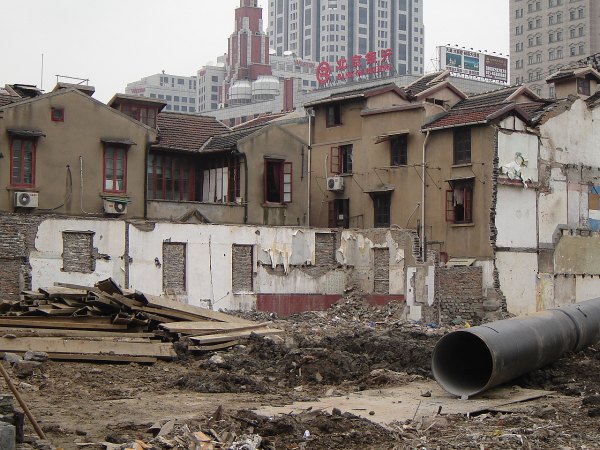
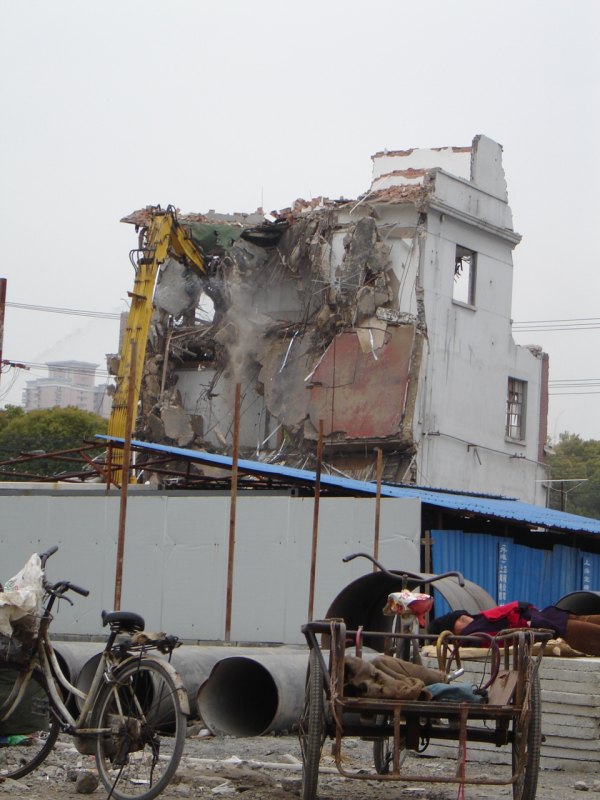
We bought some wooden bowls, a knife, and a teapot from a restaurant supply store on Renmin Road. Lisa had her favorite tailor start making her a bathrobe; we'll pick it up next week.
Then we took a long hike to the nearest subway station. China is rising, building itself up: everyone in Shanghai is busy making things, selling things.
But hiking through traffic along Huaihai Road, I got tired. The traffic etiquette in Chinese cities is strictly Darwinian. Cars dodge trucks, motor scooters dodge cars and trucks, bicycles dodge motor scooters, cars and trucks, and pedestrians like me have to dodge everything. Well, there are some rules: cars and strucks stop for stop lights, nobody else does.
Huaihai Road was all torn up with construction, like so much of the city. I became quite depressed, thinking of all these people slaving away in such ugliness, cogs in a machine they can't control, struggling to survive while enriching the already rich and powerful.
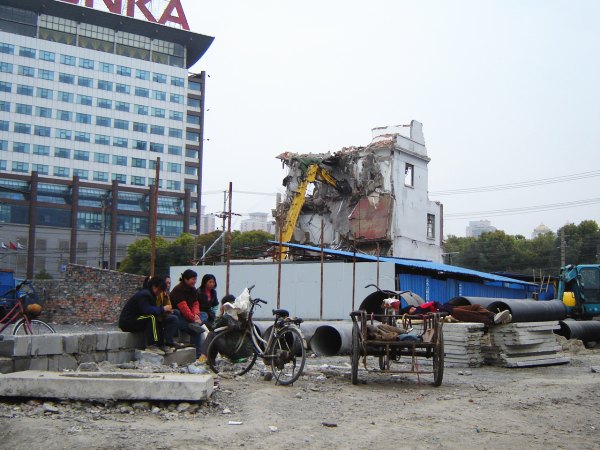
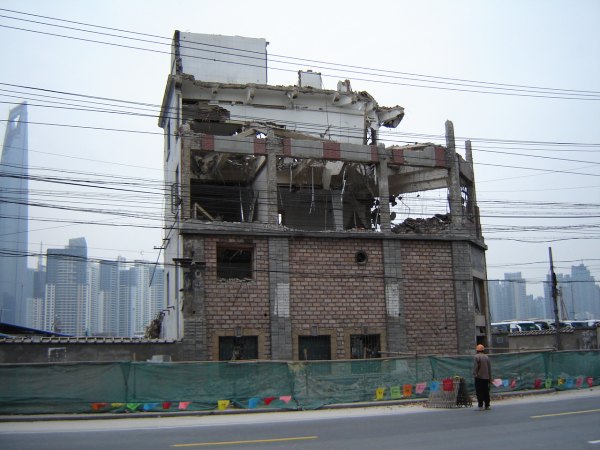
And I wondered: who among us is free to do what we really want:
what we've decided is best after considered judgement? Not necessarily
the "titans of industry" who seem to profit from all our labor.
Not necessarily the politicians, bound by the rigid rules of power.
Maybe me. Maybe Lisa's tailor, an artist at his trade. Did he
always want to be a tailor, or was he thrust into this job and
have to make the best of it? I couldn't ask him. I bet it's largely
a matter of attitude: another person in the same job could see it as
a tiring chore, but he brings a sense of style to his work, he makes
it an art, so he enjoys it — and makes everyone around
enjoy it, too.
Yesterday we looked for our favorite CD and DVD store: Artbook Rockmusic
Artmovie.
When we discovered it in 2006 it
was a small place, with a tiny cramped back
room full of arcane movies: Bunuel's L'Age D'Or, Orson Welles' Mr.
Arkadin. When Lisa visited last fall
it had moved to a slightly larger place a bit down the street.
This time we couldn't find it.
We wandered all over: a guy in a guitar store said it had moved
around the corner to Handan Road, so we walked down there. Lots of small shops selling
women's clothing, a place called Strangers Bar, but no Artbook
Rockmusic Artmovie. Finally Lisa asked for help at a camping goods store.
She had a card with the phone number of the place, and
one of the staff phoned the place, found out where it was, and walked us down
the street, aiming us in the right direction. Back to the original street...
hey, just where we were looking before! The reason we didn't find it: now
it has an even hipper name: "2046".
In case you're interested, it's on 300-8 Guoding Road.
I bought three CDs for a total of 75 yuan: Suzanne Vega's Beauty and
Crime, Future Sound of London's Teachings from the Electronic Brain,
and Rabih Abou-Khalil's Songs for Sad Women. The exchange rate is
7 yuan to the dollar, so experiments like these are affordable.
Today was perhaps our first "typical" day. We got up at
6 am and Lisa went to do taiji. Despite the lure of a warm bed
I tagged along, thinking to get a little exercise. We walked past the old men
with their bird cages, past the wet market and the xiaolong bao shop,
which still thankfully survives, down another street, past a little
stand that was selling ma chou — yum, sesame balls! — and
over to the university gymnasium. I walked briskly around the track
while Lisa waited for her taiji group to show up. They were late:
Master Ma has a new grandchild, so he doesn't show up every day,
and discipline seems to slacken a bit when he's not around.
It was fun walking around the track, thinking about local cartesian
closedness for categories of concrete sheaves, watching the crowd of
mostly older men and women jogging or walking around, some walking
backwards, some doing a bit of qi gong, with occasional people on the sidelines
doing pushups, skipping rope, and the like. Lisa's taiji group showed
up, and so did some other groups, including an impressive one dressed all
in black doing the Chen style. The morning is a nice time here: the air
is fresh, and people like to exercise in public spaces, and talk with their friends.
Afterwards, walking back, we bought two sesame balls for 0.7 yuan —
just a dime! Then we picked up some dou jiang and jian bing to take home
for breakfast. Dou jiang is a very popular soy milk drink, often served
warm — people also like a bowl of it with a "you tiao"
crumbled in — that's a fried dough stick.
Jian bing is a marvelous
kind of crepes-like breakfast dish from northern China that
people make on a big flat hotplates, usually on the side of the road.
It's pretty complicated, but they make it really quick —
I explained how in my July 7, 2006
diary entry. Alas, the place where we bought it today doesn't include
peanuts. We'll try a different place next time.
Then breakfast at home, watching the English version of Chinese TV news.
They say the Dalai
clique is inciting violence, making up lies about 40 Tibetans being
killed in the March riots — and to add insult to injury,
Westerners are siding with them, ignoring all the deaths caused
by rioters and looters, and using the business as an excuse to ruin
the Olympics!
(At home we get very different — and I hope more accurate — news.
But it's worth imagining what would happen if, back in 1893, Europe
had threatened to boycott the Chicago World's Fair unless
the US returned several western states to the indigenous peoples whom
we had slaughtered and confined to reservations. No way! We'd have
been outraged!)
Then writing this diary.
I think she's probably right: where I see a city torn apart
by construction and people working their butts off, they see
an economic boom lasting several decades that's lifted millions
from poverty to a standard of living they could never have imagined!
It's interesting that Slaughter says America has lost this spirit
of optimism.
I think that's true too, but I don't think most Americans are quite ready
to admit it yet. For example, consider the recent uproar when
Barack Obama was caught saying that many small-town Americans
have become "bitter" and turned for refuge to "God and guns".
Today was my third "typical day" in Shanghai —
except today I didn't go to the track: it was raining. Lisa still
did taiji, somewhere sheltered from the rain. But, not the
sword form; nobody wants a rusty sword. She found a
stand that does jian bing with peanuts, and brought some back for breakfast!
I've been working hard with my student Alex Hoffnung on a paper
called Smooth
Spaces: Convenient Categories for Differential Geometry.
We're fine-tuning it, it's starting to hum — it's at this stage
in writing a paper that I can write all day, touching up this
detail and that, improving the wording, reorganizing proofs,
feeling energized and happy.
But now I need to switch gears and put some time into another paper,
Representations
of 2-Groups on Higher Hilbert Spaces. Some of my coauthors
are getting antsy; they want it done now. Sounds good to me!
I'm eager to dig out of the pile of half-written papers I've buried
myself under. But this paper is at a less happy stage of its embryonic
development: in some sense it's close to done, but we still need to fight
our way through some technical issues involving measure theory. We're
not enjoying it now; we just need to do it. It takes me a bit of time to
build up momentum for struggles like this.
Still, it'll be good to to help bring categorification into
the heartlands of analysis.
Trent Reznor has some cool instrumental stuff on his new
album, Ghosts I - IV:
Seeing this makes me want to learn xiangqi, also known
as Chinese chess.
Then we visited
Lu Xun's house.
Lu
Xun is the most famous Chinese writer of the 20th century.
If you're like me, you've never heard of him, or maybe know
him as the author of Diary of a Madman.
His house was a townhouse in a cute little alley.
We went up to the window of the house nearby to buy a ticket
from a woman sitting at a desk. A tall man in civilian clothes
and some sort of military officer came out the door, and the
former asked us: "Meiguo ren? American?" Fighting back panic,
I said "Yes". Then they took us on a guided tour.
His home, three stories, was suprisingly opulent — but
as a popular writer in his day, he was quite well-off. His
books were still there, and Lisa spent a lot of time looking
at them.
But, we didn't order the dog.
This was actually the first time I'd seen dog on a menu, so I
started pondering whether I would ever eat it, why wasn't
I vegetarian, how much something
had to be like me before I'd refused to make a meal of it,
etcetera. Lisa abruptly cut short these increasingly
abstruse reflections
by saying that in any case dog was probably out of season. I was
surprised that dogs became edible only in a certain season, but
Lisa explained that old folks like to eat dog in the winter,
since it's supposed to strengthen their yang.
We also had roast frog with pepper as part of a late lunch
today at the snack shop on Siping Road. It's good! I don't
like how amphibians are going extinct, but I bet these frogs
must be farmed.
Walking down Sipailou Road in the old city, you get a sense of the
bustling vitality of a traditional urban
Chinese market — a thousand people
doing a thousand things, a thousand things to buy, not constrained
by zoning laws, not yet flattened into blandness by big corporations.
All these photos were taken in a single 20-meter stretch:
Of course, one downside is that lots of people are living right
behind these storefronts, in conditions that most Americans
(at least) would find pitifully squalid. See that ramshackle
house in the back of the above picture? Here's a picture of the
other side, taken by Lisa — I bet a lot of people live here:
you can bet someone's playing cards.
Guys also gather to watch guys playing Chinese chess:
And these people are not sneaking tippy-toe across the park;
they're doing taiji, strangely late in the
day, around 3 pm:
Then we visited Sun-Yat
Sen's house nearby at 7 Xiangshan Road, and the museum
they've built there. I found it moving,
both for the hopes that Sun Yat-Sen had, and for how they went
awry (as usual with revolutions).
As the father (in some sense) of both the Kuomintang
and the Chinese Communist Party, Sun Yat-Sen is revered both in Taiwan
and the People's Republic of China.
Born in 1866, he was trained as a physician — like
Lu Xun. In 1894 he wrote a long
letter to the governor-general of the province of Zhili,
who was a reformer, but he was rebuffed... and thenceforth
he became a revolutionary.
While ceaselessly planning and
raising funds for his revolutionary activities, often in exile,
he also read and wrote voraciously. The museum displayed copies
of books by Russell and Schopenhauer that he had reviewed, as
well as a book on nutrition. Also the books he wrote.
Later: the French curves he used to plan railroad lines,
the edict where he introduced the use of the solar calendar,
and a pigtail or "queue" shorn from someone's head
as a result his order banning this hairstyle, which had
been imposed in 1644 by the Manchus. Busy guy!
But, as usual with revolutions, all his idealism was
caught in the undertow real-world politics and subverted.
He reached his height of power in 1912, as
the first provisional President of the Republic of China.
He allied himself with
military leader Yuan
Shikai, who helped the Kuomintang force out the Empress
Dowager Longyu, and then became Provisional President himself,
but then cracked down on the KMT. Sun Yat-Sen led a revolt against
Yuan Shikai, which failed, so he fled to Japan.
Yuan Shikai named himself emperor; a complicated set of fights
involving local warlords then ensued. Sun Yat-Sen returned to
southern China in 1921 and was elected president and generalissimo.
He allied himself with the communists in the attempt to retake
the north... but died of liver cancer in 1925.
It makes me want to read more about this period of Chinese history:
the late Qing dynasty, its fall, and the revolutions and warfare
that followed.
Following Lisa's example, on Monday I bought an MP3 player
at a local electronics store. Not an Ipod — a Teclast
TL-C260. It supposedly has 2 gigabytes of memory, and it's
nice and cheap: 330 yuan, or about $47. Right now I'm
trying to get it to work, so far without success.
A near-featureless flat interface and a manual in Chinese make this
a bit tricky — sort of like an alien artifact in a science
fiction story. But Lisa got hers to work (an earlier, less
cryptic model) and loves it. And, the salespeople in that store
are actually quite reliable — though I naturally lean towards
skepticism, if I can't get it to work soon, I bet they'll show me
how (or admit it's busted and give me a new one).
Looking for a manual in English on the web, it seemed the only
way to get one was to join a forum called
MP4 Users; the company
is Chinese so I think it was these enthusiasts who translated
the manual. And while looking around, I found a bit about
Chinese MP4 players...
Yes: I said I bought an MP3 player, but I did that just to sound
comprehensible to Americans. Here in China MP4
players, which also play videos, are all the rage — and
that's what I got. Wikipedia has an
amusingly
derogatory article on them. It begins:
A majority of these players are actually incompatible with the format,
and are limited to low-grade proprietary formats[1] that are considered to be cheaper alternatives for these players.

April 15, 2008
My gloomy reflections above may not be shared by the Shanghainese themselves,
or at least not most. Like Americans from the late 1800s until a few
decades ago, they have a can-do, optimistic spirit! At least that's
what this person thinks:
April 16, 2008
We took the 139 bus from Fudan University to Lu Xun Park,
a nice big park not too far from here. The cherry trees and plum
trees were blooming, so, having read plenty of Chinese and Japanese
literature, I finally got to see what all the fuss is about. Here's
a photo Lisa took:
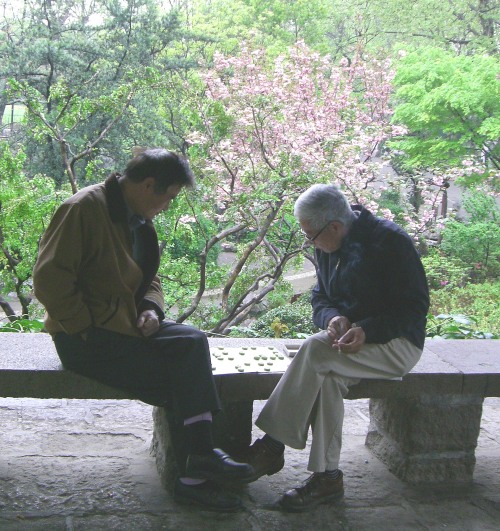
April 17, 2008
Yesterday we had dinner after 9 pm, so we did
takeout at one of the that stays open late on the
pedestrian street near Fudan University (one of our main hangouts,
lined with restaurants). It's a Szechuan place, so we had spicy lamb,
eggplant with peppers (but sweet, a concession to Shanghai taste),
frog, and rice. Yes, frog!
April 18, 2008
Lisa and I went downtown to pick up the bathrobe made by her
tailor — I took a picture of this and stuck it back
near the end of my April 13th entry.
Then we explored the old city. It was a great day, invigoratingly
cool — and sunny, for the first time since I've been here.
A perfect spring day. So, I took a lot of photos.
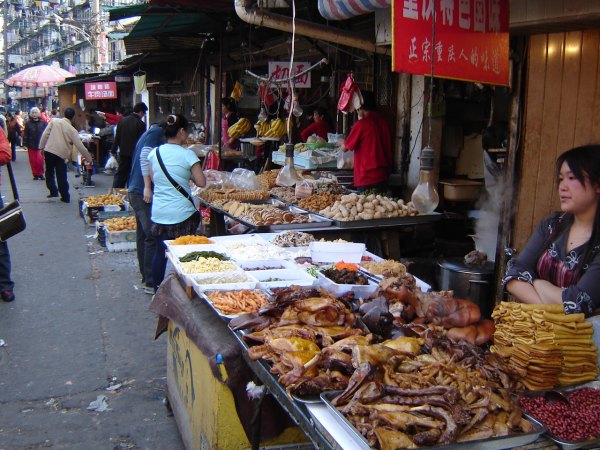

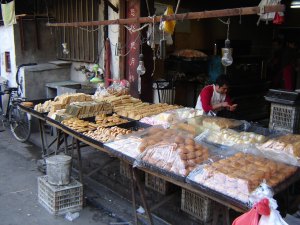

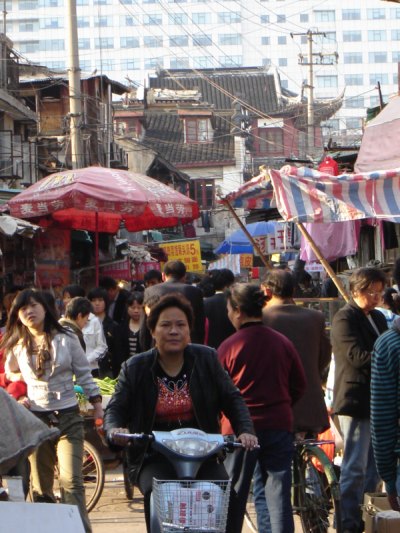

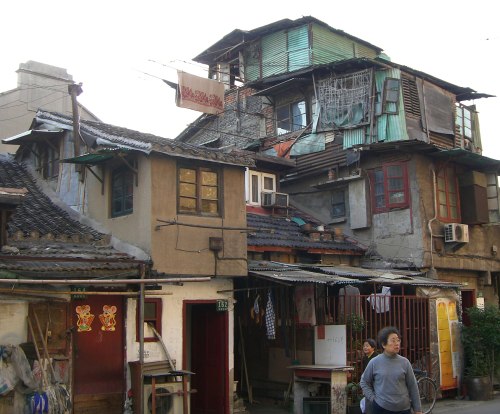
Here's a picture of a shoemaker on Sipailou Road, also taken
by Lisa:
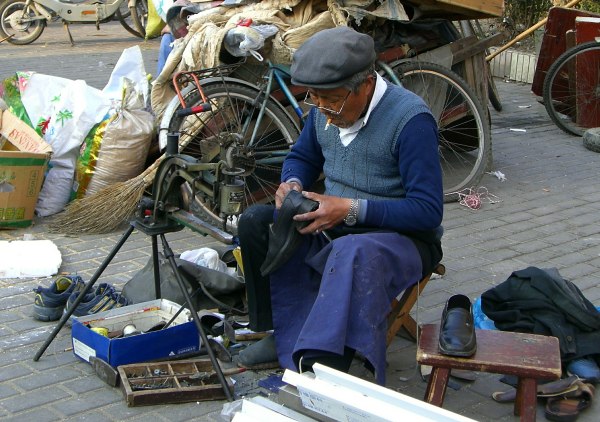
April 20, 2008
We went down to the French Quarter today. We had tea in
Fuxing Park, a popular location for families and old folks:
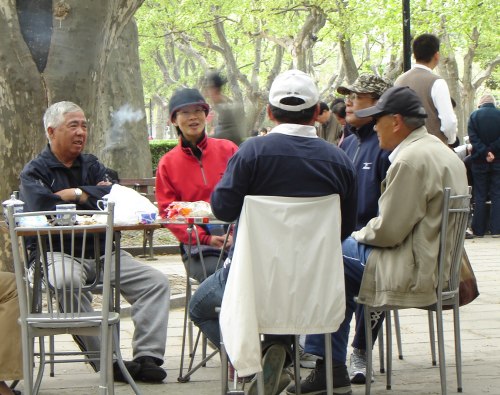
If you see a bunch of guys doing this in China:
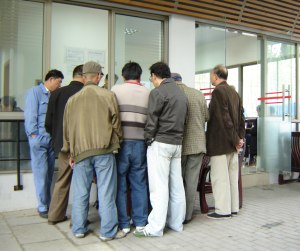
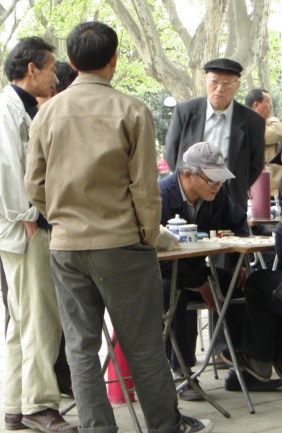
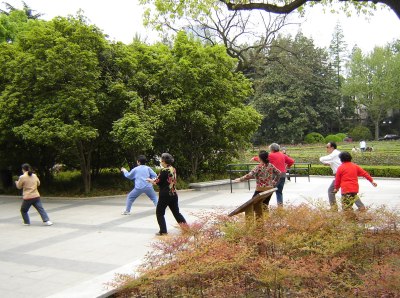
April 24, 2008
It's Wednesday, and I'm leaving on Saturday. Soon, all too soon!
I'll miss this place.
MP4 players are portable media players developed in the
People's Republic of China and surrounding regions which support the
MPEG-4 video format.
It then describes some of these formats, for example
AMV:
The image compression algorithm of this format [4] inadequate by modern standards (about 4 pixels per byte, compared with over 10 pixels per byte for MPEG-22 / DVD video), with a typical resolution of 128 × 96 pixels and a framerate of 12 fps. A 30-minute video will be compressed into just 80 MB with a very lossy bitrate.[5]You don't need to know what all this means to pick up on the scornful tone. More relevant to my own problem is the section on instruction manuals:
Manuals that are bundled with these players are considered to be inconsistent and are generally difficult for users to comprehend due to its poor translation.[6] Manuals may also refer to features that the particular player model may not possess. And due to the nature of the product, there is usually no contact or website information.Wikipedia is now urging that articles include authoritative sources, so you can click on the footnote and read Amazon reviews of a "1GB Pastel Pink Mp4-Mp3 Player" that say things like:
I bought this MP3/4 player for my little sister for Christmas, and so far I am very pleased. The sound quality is great and visually it is very attractive, however it is a lot smaller than what I expected. Consequently the pictures when viewed are quite small and blurred. I am having trouble reading the instructions which have been changed directly from Chinese and make no sense!! Consequently I haven't been able to make use of all the player's features and I still cannot change and store videos on the player. Despite this, it is a great little player & great value for money!! I am very happy!!The point is: these Chinese MP4 players are so cheap you don't care that they're not perfect and you can't read the instructions — or at least you shouldn't. Another reviewer writes: "I purchased this not knowing its size. It's tiny, the size of a matchbox." That reminds me of an incredibly small one I saw in the store here, about the size of my thumbtip. Maybe that was just an MP3 player, but still: how do you work something so small?
But the really informative website on these machines is this:
The author goes on to describe various southern Chinese MP4 players and their features, emphasizing: "there is no such thing as a perfect Mp4 player. Every machine is lacking something, missing a promised capability, or in need of altering the way something works."How Apple Shaped the Southern Chinese Industry
Long before Apple launched its iPod range of players, the Southern Chinese electronics industry was already buzzing with activity in building personal instruments that could play CDs, could records from FM radio stations and replay as many times as you want music from that source, and in building for western countries small players that could house a range of .mp3 format tunes. It was in 1998 that Eiger Labs in Europe created the first "non-mechanical" .mp3 player that could continue playing regardless of the external shock caused to the player. Interestingly, Apple Computer's iPod range started not from this "non-mechanical" concept but rather from the concept of housing a mini-disk drive.It was the popularity of the non-mechanical machines that began a stream of new products from around the world made by Eiger Labs, HanGo Electronics (Southern China), EmpegCar, and many others. Just about every manufacturer of consumer electronics had a version. Then came Apple iPod that from 2001 and onward manufactured a number of versions of its popular player all with its signature round sensor keypad. The important thing to note here is that while Apple is a worldwide company with its base strongly in the USA, Apple subcontracted the manufacture of its iPod range to a number of manufacturers all of whom were based or who had their primary base in Southern China.
Basically because of the large numbers of iPods Apple was now selling, Apple controlled the price of "flash memory" the solid state memory used in the most popular iPods, and also now the most popular non-iPod machines that were made by a number of manufacturers to meet Apple on the non-mechanical turf. Apple also controlled a large portion of the Southern Chinese manufacturers due to the Apple Accessories it was producing and having produced by manufacturers under license.
Hundreds of manufacturers in Southern China wanted to have a slice of the "Apple-pie" and were preparing themselves to compete for licenses in producing Apple iPods or accessories. Most manufacturers were not accepted for one reason or another. Having gained skills in manufacture to build iPod type machines, it was these manufacturers who began flooding the worldwide marketplace with a range of iPod look alikes, as well as many other designs of .mp3 players.
The MP4 Advantage
The bulk of manufacturers in Southern China having lost out in making iPods for Apple turned their expertise elsewhere — making Apple iPod look alikes. Chinese people have a very different view on art, the expression of art, and the way in which items are made, authored, or invented. If a very talented person painted the Mona Lisa, then it is the duty of an artist who comes after that famous painting and painter to perfect that art, or to change that piece of art with a new rendition. So it was with the arrival of the iPod. If there was an iPod there should be a way for me, as a manufacturer, to build a better iPod, an iPod with a different screen that would be useful to some other types of people using iPods.However, a number of manufacturers saw that they could build a competitive advantage over an iPod. Apple iPod's at the time in 2001, only played MP3 music format. The Southern Chinese factories saw a competitive advantage that they could bring to the marketplace — manufacture an MP4 Player — which in their interpretation of file formats is the populist format for video and video-like format that encases the details necessary to reproduce a video picture along with music.
There are about 350 factories, assembly plants and marketing offices housed in the sprawling metropolis of Shenzhen. Some of them have good research and development facilities whilst others have purely a marketing interface to the world or have an assembly plant. Typically since 1998, any new producers/sellers of "iPod" look alikes, and MP4 players, buy a wholesale pack of gear necessary to build a "common mould" product; that is, a mould that is also sold to many other manufacturers. A new producer takes this common mould product and what is basically an inventory of parts needed to assemble a product that looks like any other producer's product. However, to be true to the Chinese manufacturing ethos, the new producer needs to do something quite different to the common mould product that improves the look, operation or whatever of the product. Therefore we have in the marketplace today, hundreds of MP4 machines that look very much the same, but have some distinctive change technically or otherwise.
The reference to 350 factories, assembly plants and marketing offices in Shenzhen reminds me of my visit to Shenzhen in August 2005. It's quite a city. Not a tourist destination, except for shoppers from Hong Kong trying to save money. But, it could be the city of the future.
April 25, 2008
My last full day here — my flight leaves tomorrow at
7:30 pm. I'll miss Shanghai, and miss Lisa too.
Lisa got up at 6:20 am to do her taiji with Lao Ma and the rest of the gang. The others leave around 7:45 but he stays longer to teach her extra stuff, and today he started teaching her the 42 — the only Yang style sword form she he hasn't learned yet. She'd been hoping for this, but not expecting it, since Ma is getting old and busy with grandchildren. Different forms are named after the number of movements; here's a video of the 42:
Being a lazy bum, I woke up around 7:30 and went out to meet her. It's was a perfect sunny but crisp spring morning. The bird fanciers were out in force, and I wished I'd brought my camera.We came back and en route we got jian bing for breakfast as usual; being almost my last day I thought I'd try something different for a change, so I had mine with a cruller inside instead of the usual crunchy cracker. Bad move! The crunch turns out to be a key aspect of the jian bing's charm.
We also picked up a kind of scallion cake cooked in a tandoori-like oven at the usual sesame ball place, on the same "now or never" principle — and these turned out to be okay, though Lisa liked them more than I did.
Later we took a walk and I picked up Chinese editions of Griffiths and Harris' Principles of Algebraic Geometry and Marsden and Ratiu's Introduction to Mechanics and Symmetry for 78 and 72 yuan, respectively, at a book store near Fudan University. They have a lot of math and physics books! I've been trying to learn some algebraic geometry lately, so it'll be fun to tackle Griffiths and Harris again. When I tried it back in grad school I didn't get much past the basics of sheaves, deRham and Doubeault cohomology, and Hodge theory, but now the stuff on curves and abelian varieties looks mouth-watering.
Yesterday we took my Teclast MP4 player back to the store; it just didn't work at all! They replaced it with a good one, and took the trouble to switch the language from Chinese to English — excuse me, that's not English, it's Russian! — okay, English. And today Lisa and I figured out how to download some MP3s into, starting with what she had available: Dylan's Desire, Satie's Gymnopedie, Dao Lang's 2002 Nian De Di Yi Chang Xue and Yo-Yo Ma's Classic Yo-Yo.
So, now I'm finally part of the MP3 generation! In a few weeks they'll probably move on to something else...
I don't know if you've been paying attention to the world food crisis. I tend not to mention news here if I feel everyone knows it already, but on the off chance you don't, listen to some of these stories:
Another much-ballyhooed factor is the way grain is going to make ethanol. That would be scary if true: have we already reached the point where rising energy prices suck major amounts of grain from starving poor countries into American SUVs? It's hard for me to tell. The columnist Roger Cohen says it's exaggerated. But I'd like to see more hard numbers.
National Public Radio has been talking about rising food prices for weeks, but now I see people up in arms about how Wal-Mart and Costco are limiting sales of rice. It seems that the Australian press is making an especially big deal about this, calling it "rationing".
Some climate news: according to Sarah Das of Woods Hole and Ian Joughin of the University of Washington, Greenland is not giving way to catastrophic melting. Meltwater is forming underground streams that lubricate the slide of glaciers, already doubling their rate of motion in some places. Das and Joughin just found that lakes on the surface can quickly cut through ice all the way down to the rock far below. They saw a lake of meltwater containing 45 million cubic meters of water drain completely in an hour and a half — a flow of 8,000 cubic meters per second, more than Niagara Falls. The water seems to have cut through over a kilometer of ice to the rock below! But, the rate of outflow of glaciers at the sea's edge is not drastically speeding up. Right now they're raising global sea levels at less than a quarter inch per century.

We've been having a lot of trouble with bark beetles killing pines in the San Bernardino mountains near Riverside, causing bad fires — but it's nothing compared to this:
So, we have a positive feedback loop: warmer climates mean more beetles mean more CO2 mean warmer climates, at least until the pine forests all die.
Ready for some good news? I recently heard about an interesting negative feedback loop: the increased amount of CO2 dissolved in seawater seems to be leading to a rise in little algae called coccolithophores that have calcium carbonate "shells". When these shells fall to the sea floor, it takes CO2 out of circulation. This fits nicely with Le Chatelier's principle — but scientists had been expecting the opposite, since more CO2 in the water makes it more acidic, which tends to dissolve sea shells and coral reefs and release more CO2. So, this comes as a nice surprise, especially since there are a lot of these coccolithophores — apparently they play a big role in taking CO2 out of the atmosphere:
April 28, 2008
Back home, jetlagged and slightly sick, busy trying to make
a deadline on a grant proposal to get money for my students.
On the shuttle ride back from the airport late Saturday
night, I saw the hills of Sierra Madre
on
fire. We're having record heat here - 100 Fahrenheit in
April is unusual! (That's 38° C.)
It's very strange having fires so early in the spring — not a good sign. On the TV show 60 Minutes I hear that half the forests in America are likely to be gone in the next century, victim to fires, thanks in part to global warming.
If you've enjoyed my Shanghai diary, try this:
April 30, 2008
Jimmy Giuffre died last week. My dad had a great album by him...
I need to get ahold of it:
Here you can see Billie Holiday, Ben Webster, Lester Young, Coleman Hawkins and Gerry Mulligan all together. This is their December 8th, 1957 performance of Billie Holiday's song Fine and Mellow, from the CBS television special The Sound of Jazz.
You can see the sadness in Billie's eyes turn to a smile as she listens to Lester Young's solo. Long past his prime, he had to summon up his strength to stand up for this. He drank himself to death 15 months later. He was the one who named Billie "Lady Day". She called him "The Pres". They'd had a close artistic relationship for many years. I can't help but wonder if they were in love, but Billie seemed to always be involved with abusive men.
(Her second husband, whom she married in 1952, was an enforcer for the Mafia. Like her other men, he beat her. But — all her biographers say at this point — at least he tried to get her off drugs. You see, she'd gotten into heroin in her later years, and had been busted a few times, put in prison for a year... and in 1947 she'd been banned from performing in all clubs in New York. "I can play Carnegie," she said, "but I can't play the crummiest gin joint in New York." Still, somehow she managed to sing regularly at Birdland.)
On the ride to Lester Young's funeral, Billie Holiday told the jazz critic Leonard Feather, "I'll be the next one to go". Sure enough, she died only 4 months later, from cirrhosis of the liver, under house arrest at the hospital for heroin possession. When her body was examined she was found to have $750 taped to her leg. She had only 70 cents in the bank. She was 44 years old. She is buried in St. Raymonds Cemetary in the Bronx.
Sad self-destructive behavior. But somehow all the foolish misery of their lives is transmuted to beauty in the alchemy of music.
This was her most devastating song of all:
From happier days:

Here's to Billie! I've been listening to her stuff a lot these days.
Through new uses of corporations, banks and securities, new machinery of industry, of labor and capital — all undreamed of by the Fathers — the whole structure of modern life was impressed into the service of economic royalists. It was natural and perhaps human that the privileged princes of these new economic dynasties, thirsting for power, reached out for control of government itself. They created a new despotism and wrapped it in the robes of legal sanction. - Franklin Roosevelt
© 2008 John Baez
baez@math.removethis.ucr.andthis.edu